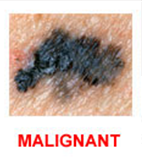By Dr. Deborah Sarnoff
May is Skin Cancer Awareness Month so now is as good a time as ever to give our skin a self check-up and learn how to recognize the potential signs of melanoma. If spotted early, melanoma is almost always curable. But if spotted late, melanoma could be lethal.
Melanoma is the most common form of cancer for young adults, aged 25-29 years old and the second most common one for young people between the ages of 15 and 29 years old. Although Caucasians with blonde or red hair are at a greater risk for developing skin cancer than the general population, no one is immune. People of color can also get melanoma and other types of skin cancer.
The more aware you are of what to watch out for, the better you can prevent an unfortunate incident.
When looking at your skin, the first thing to look for is the “ugly duckling” sign. Take a look at your skin and carefully examine your moles. We usually have moles that look similar to one another. If you see a mole that looks different from the rest – the ugly duckling – it could be a potential sign of something more serious.
With the help of my friends at the Skin Cancer Foundation, I’ve provided a quick and easy method for determining when to get a mole or a mark on your skin checked out by a dermatologist.
It’s called the ABCDE rule: Asymmetry, Border irregularity, Color that is not uniform, Diameter greater than 6 mm — (about the size of a pencil eraser), and Evolving size, shape or color.

Let’s learn our ABCDE’s:
A – Asymmetry: If you drop an imaginary line down middle of the mole, is it like a mirror image that is equal on each side? If so, it’s symmetrical. But if the mole is asymmetrical, get it checked out by a dermatologist.
B – Border: Is the border of the mole smooth? Or is it irregular? If the border is not smooth or even, but rather jagged or notched, I recommend getting it examined by a physician.
C – Color: Benign moles, as a rule, are usually uniform in color. However, if your mole is variegated in color i.e. parts of the mole are brown and other parts are black or tan etc., then it could be a potential problem.
D – Diameter: As a rule, benign moles are smaller than an eraser on a pencil. If your mole is larger than a pencil eraser (approx. 6mm), ask your dermatologist to take a look at it.
E – Evolving: If you notice a change in a mole – for example, the mole appears to raise up when it had previously been flat or it grows bigger in size, this is a sign there could be something wrong.
Most skin cancers, including melanoma, are caused by sun exposure, but there are other types of melanoma that do not result from sun damage. Therefore, when checking your skin, it’s important to check the places where the “sun don’t shine” as well.
Important, but often overlooked places to check:
- Scalp – Since it’s hard to see your own scalp, I recommend asking a spouse, a friend or whoever washes your hair at the salon to take a look.
- Mouth – Occasionally, skin cancers can develop in strange places – most notably mucous membranes. Since, skin cancers can sometimes develop on the roof of the mouth, it may be a good idea to ask your dentist to take a look the next time you get your teeth cleaned.
- Genital area or around the anus and rectum
- Between the toes
- Under the fingernails – If you notice pain, an elevation in your nail, or a brown or black stripe on your nail, have it examined by a doctor.
Use two mirrors to check your back, the back of your neck, and your buttocks.
While melanomas are usually dark in color, they can sometimes manifest as a pink bump with no pigment. This is known as an amelanotic melanoma. It will often appear to come out of nowhere and start growing bigger and bigger. Eventually, it may even start to bleed.
Now that you are familiar with the common signs to watch out for and where to look, you are much better prepared to spot a melanoma in the early stages when it is still easily curable.
Note, this list is not comprehensive. If you notice anything new and unusual on your skin, have it checked out by a medical professional, preferably a board certified dermatologist.
Do your part during this Skin Cancer Awareness Month and share the knowledge!
Spotting it early could save your life or the life of a loved one.
